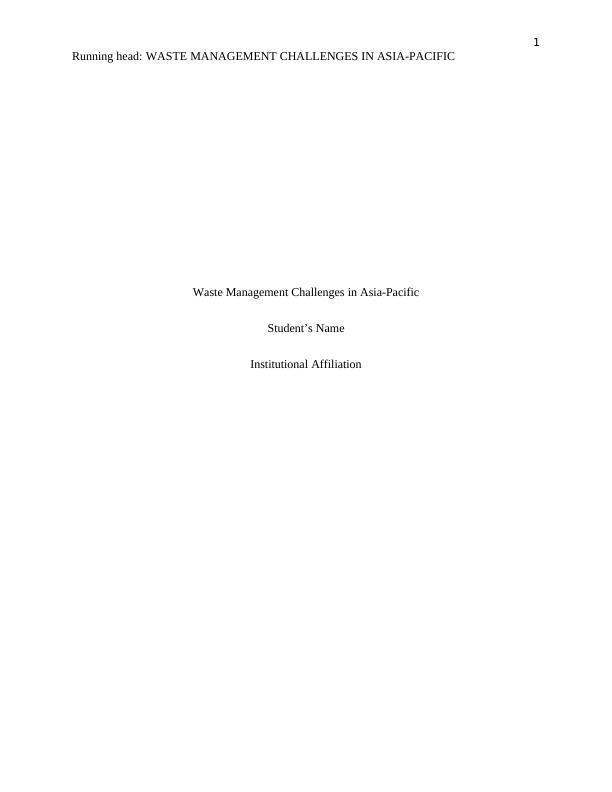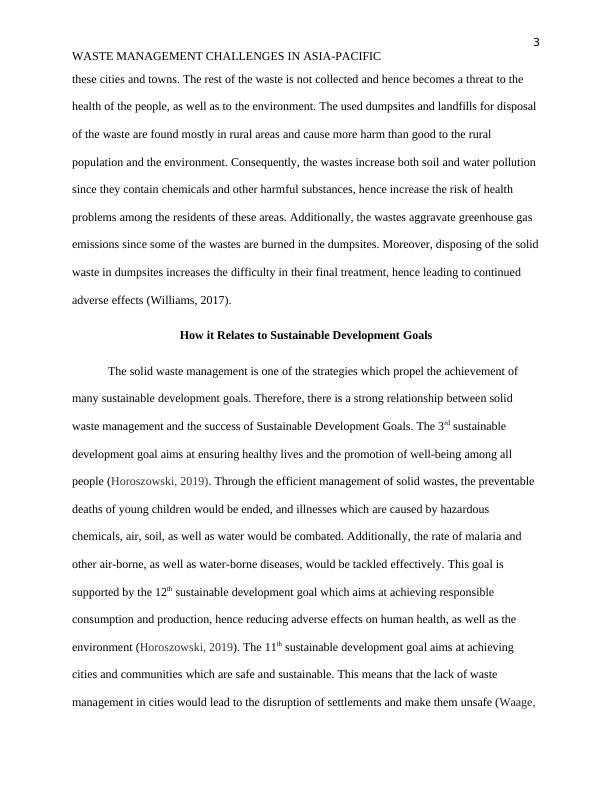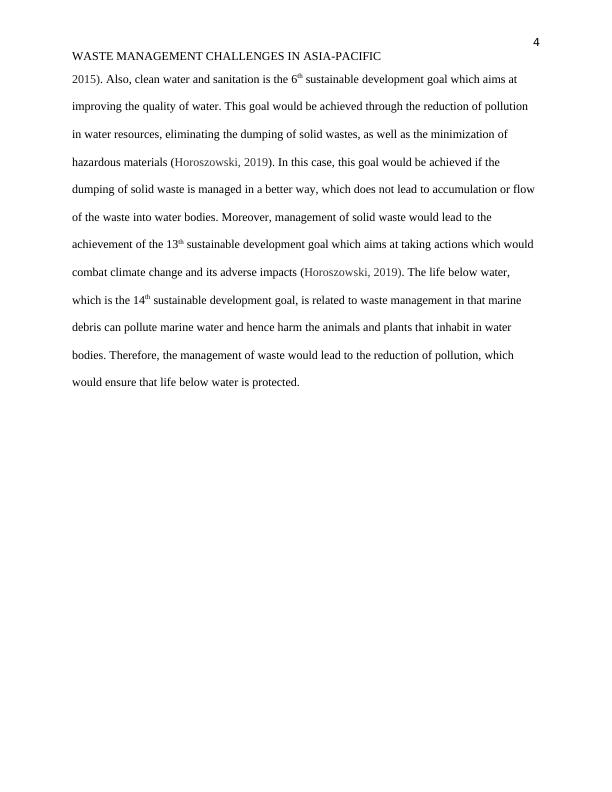Waste Management Challenges in Asia-Pacific
Added on 2023-01-19
11 Pages2184 Words27 Views
1
Running head: WASTE MANAGEMENT CHALLENGES IN ASIA-PACIFIC
Waste Management Challenges in Asia-Pacific
Student’s Name
Institutional Affiliation
Running head: WASTE MANAGEMENT CHALLENGES IN ASIA-PACIFIC
Waste Management Challenges in Asia-Pacific
Student’s Name
Institutional Affiliation

2
WASTE MANAGEMENT CHALLENGES IN ASIA-PACIFIC
Introduction
There are various strategies which can be practiced in the strive to achieve the
Sustainable Development Goals. The achievement of Sustainable Development Goals would
bring about a positive impact on the entire human race and the environment. In Asia-Pacific, the
issue of solid waste management is a challenge. Management of solid waste is a significant
concern which, if successively achieved, would lead to the attainment of several sustainable
development goals. The solution to this challenge in Asia-Pacific is the project known as
Integration of Resources and Recovery Center, which uses low-cost strategies and the local
community to deal with urban solid waste. The local community would be encouraged in the
management of solid waste through awareness building, provision of jobs, and establishment of
laws and policies which compel them to be responsible for waste management.
What is the Problem Being Investigated?
The developing countries in Asia-Pacific are facing the challenge of solid waste
management. This challenge is mostly affecting secondary cities and other small towns.
Williams (2017) argues that these developing countries are having an increased rate of
urbanization, which is attracting a high population. The result of the increase of people is the
increment in the accumulation of solid wastes in urban areas. Marine debris are also an issue in
these countries (McIlgorm, Campbell and Rule, 2011). However, these countries have a
challenge in obtaining waste management solutions which are cheap and which make use of
locally available resources (Williams, 2017). The solution which has been used in many of these
cities and towns is the partial collection, transportation, and disposal of the solid waste into
landfills, as well as dumpsites. This solution is what Williams (2017) calls the end-of-pipe
solution, which is not effective since it only collects approximately 50-60% of the solid waste in
WASTE MANAGEMENT CHALLENGES IN ASIA-PACIFIC
Introduction
There are various strategies which can be practiced in the strive to achieve the
Sustainable Development Goals. The achievement of Sustainable Development Goals would
bring about a positive impact on the entire human race and the environment. In Asia-Pacific, the
issue of solid waste management is a challenge. Management of solid waste is a significant
concern which, if successively achieved, would lead to the attainment of several sustainable
development goals. The solution to this challenge in Asia-Pacific is the project known as
Integration of Resources and Recovery Center, which uses low-cost strategies and the local
community to deal with urban solid waste. The local community would be encouraged in the
management of solid waste through awareness building, provision of jobs, and establishment of
laws and policies which compel them to be responsible for waste management.
What is the Problem Being Investigated?
The developing countries in Asia-Pacific are facing the challenge of solid waste
management. This challenge is mostly affecting secondary cities and other small towns.
Williams (2017) argues that these developing countries are having an increased rate of
urbanization, which is attracting a high population. The result of the increase of people is the
increment in the accumulation of solid wastes in urban areas. Marine debris are also an issue in
these countries (McIlgorm, Campbell and Rule, 2011). However, these countries have a
challenge in obtaining waste management solutions which are cheap and which make use of
locally available resources (Williams, 2017). The solution which has been used in many of these
cities and towns is the partial collection, transportation, and disposal of the solid waste into
landfills, as well as dumpsites. This solution is what Williams (2017) calls the end-of-pipe
solution, which is not effective since it only collects approximately 50-60% of the solid waste in

3
WASTE MANAGEMENT CHALLENGES IN ASIA-PACIFIC
these cities and towns. The rest of the waste is not collected and hence becomes a threat to the
health of the people, as well as to the environment. The used dumpsites and landfills for disposal
of the waste are found mostly in rural areas and cause more harm than good to the rural
population and the environment. Consequently, the wastes increase both soil and water pollution
since they contain chemicals and other harmful substances, hence increase the risk of health
problems among the residents of these areas. Additionally, the wastes aggravate greenhouse gas
emissions since some of the wastes are burned in the dumpsites. Moreover, disposing of the solid
waste in dumpsites increases the difficulty in their final treatment, hence leading to continued
adverse effects (Williams, 2017).
How it Relates to Sustainable Development Goals
The solid waste management is one of the strategies which propel the achievement of
many sustainable development goals. Therefore, there is a strong relationship between solid
waste management and the success of Sustainable Development Goals. The 3rd sustainable
development goal aims at ensuring healthy lives and the promotion of well-being among all
people (Horoszowski, 2019). Through the efficient management of solid wastes, the preventable
deaths of young children would be ended, and illnesses which are caused by hazardous
chemicals, air, soil, as well as water would be combated. Additionally, the rate of malaria and
other air-borne, as well as water-borne diseases, would be tackled effectively. This goal is
supported by the 12th sustainable development goal which aims at achieving responsible
consumption and production, hence reducing adverse effects on human health, as well as the
environment (Horoszowski, 2019). The 11th sustainable development goal aims at achieving
cities and communities which are safe and sustainable. This means that the lack of waste
management in cities would lead to the disruption of settlements and make them unsafe (Waage,
WASTE MANAGEMENT CHALLENGES IN ASIA-PACIFIC
these cities and towns. The rest of the waste is not collected and hence becomes a threat to the
health of the people, as well as to the environment. The used dumpsites and landfills for disposal
of the waste are found mostly in rural areas and cause more harm than good to the rural
population and the environment. Consequently, the wastes increase both soil and water pollution
since they contain chemicals and other harmful substances, hence increase the risk of health
problems among the residents of these areas. Additionally, the wastes aggravate greenhouse gas
emissions since some of the wastes are burned in the dumpsites. Moreover, disposing of the solid
waste in dumpsites increases the difficulty in their final treatment, hence leading to continued
adverse effects (Williams, 2017).
How it Relates to Sustainable Development Goals
The solid waste management is one of the strategies which propel the achievement of
many sustainable development goals. Therefore, there is a strong relationship between solid
waste management and the success of Sustainable Development Goals. The 3rd sustainable
development goal aims at ensuring healthy lives and the promotion of well-being among all
people (Horoszowski, 2019). Through the efficient management of solid wastes, the preventable
deaths of young children would be ended, and illnesses which are caused by hazardous
chemicals, air, soil, as well as water would be combated. Additionally, the rate of malaria and
other air-borne, as well as water-borne diseases, would be tackled effectively. This goal is
supported by the 12th sustainable development goal which aims at achieving responsible
consumption and production, hence reducing adverse effects on human health, as well as the
environment (Horoszowski, 2019). The 11th sustainable development goal aims at achieving
cities and communities which are safe and sustainable. This means that the lack of waste
management in cities would lead to the disruption of settlements and make them unsafe (Waage,

4
WASTE MANAGEMENT CHALLENGES IN ASIA-PACIFIC
2015). Also, clean water and sanitation is the 6th sustainable development goal which aims at
improving the quality of water. This goal would be achieved through the reduction of pollution
in water resources, eliminating the dumping of solid wastes, as well as the minimization of
hazardous materials (Horoszowski, 2019). In this case, this goal would be achieved if the
dumping of solid waste is managed in a better way, which does not lead to accumulation or flow
of the waste into water bodies. Moreover, management of solid waste would lead to the
achievement of the 13th sustainable development goal which aims at taking actions which would
combat climate change and its adverse impacts (Horoszowski, 2019). The life below water,
which is the 14th sustainable development goal, is related to waste management in that marine
debris can pollute marine water and hence harm the animals and plants that inhabit in water
bodies. Therefore, the management of waste would lead to the reduction of pollution, which
would ensure that life below water is protected.
WASTE MANAGEMENT CHALLENGES IN ASIA-PACIFIC
2015). Also, clean water and sanitation is the 6th sustainable development goal which aims at
improving the quality of water. This goal would be achieved through the reduction of pollution
in water resources, eliminating the dumping of solid wastes, as well as the minimization of
hazardous materials (Horoszowski, 2019). In this case, this goal would be achieved if the
dumping of solid waste is managed in a better way, which does not lead to accumulation or flow
of the waste into water bodies. Moreover, management of solid waste would lead to the
achievement of the 13th sustainable development goal which aims at taking actions which would
combat climate change and its adverse impacts (Horoszowski, 2019). The life below water,
which is the 14th sustainable development goal, is related to waste management in that marine
debris can pollute marine water and hence harm the animals and plants that inhabit in water
bodies. Therefore, the management of waste would lead to the reduction of pollution, which
would ensure that life below water is protected.

End of preview
Want to access all the pages? Upload your documents or become a member.
Related Documents
Rural Solid Waste Management PDFlg...
|18
|3306
|33
Solid Waste Management in Malaysialg...
|15
|4216
|85
Decentralised Water and Wastewater Treatment in Kuwaitlg...
|6
|1368
|367
Waste Management in Malaysialg...
|10
|2850
|1
Current Municipal Solid Waste Management in Vietnamlg...
|13
|3684
|429
Dissertation Proposal on Waste Managementlg...
|40
|11409
|175
